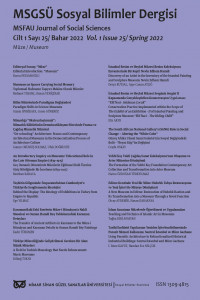İstanbul ve Siluet Muamması
ara yüz, kökensellik, tasavvur, kültürel miras, tarih, siluet
Istanbul and the Conundrum of Silhoutte
Interface, primordial, envision, cultural heritage, history, sillhouette,
___
- ALTUĞ, Evrim, “Sanatta Yeni Müdafaa”, Radikal Gazetesi, 30 Eylül 2000.
- ALTUĞ, Evrim, “Bienal’den Dünyaya İniş”, Radikal Gazetesi, 23 Ekim 2001.
- BAYKAL, Emre (Ed.), 5. Uluslararası İstanbul Bienali, İstanbul Kültür Sanat Vakfı Yayını, İstanbul, 1997.
- BLOCK, Rene, “İstanbul’a Nasıl Bir Sanat Bienali”, Hürriyet Gösteri, S.179, Ekim 1995, s. 20-23.
- ÇALIKOĞLU, Levent, “Bienal Seçkisi”, http://www.sanalmuze.org
- ÇALIKOĞLU, Levent, “Merkez Dışı, Sokağa Yayılan, Kendi Mikro Söylemini Fısıldayan Bienal”, http://www.sanalmuze.org
- DERRIDA, Jacques-DUFOURMANTELLE, Anne, On Hospitality (Cultural Memory in the Present), Trans. Rachel Bowlby, Stanford University Press, California, 2000.
- EVRENGİL, Efza, 8. Uluslararası İstanbul Bienali, İstanbul Kültür Sanat Vakfı Yayını, İstanbul, 2003.
- GRAF, Marcus, “Uluslararası İstanbul Bienali 1987-2007”, Çev. Burcu Pelvanoğlu, Kullanma Kılavuzu: Türkiye’de Güncel Sanat 1986-2006, Yay. Haz. Halil Altındere, Süreyya Evren, Art-ist Yayınları, Revolver, İstanbul, Frankfurt, 2007, s.64-73.
- GÜN, Aydın, “Kendi Tarihimizle Hesaplaşmak Böylece Çağdaşlaşmak Zorundayız”, Cumhuriyet Gazetesi, 4 Ekim 1987.
- KARAGÖZ, Hüseyin (Ed.), 7. Uluslararası İstanbul Bienali, İstanbul Kültür Sanat Vakfı Yayını, İstanbul, 2001.
- KOLDAŞ, Nihal G. (Ed.), 6. Uluslararası İstanbul Bienali, İstanbul Kültür Sanat Vakfı Yayını, İstanbul, 1999.
- LEIBNIZ, G.W., Monadoloji, Çev. Suut Kemal Yetkin, M.E.B. Yayınları, İstanbul, 1988.
- MADRA, Beral, İki Yılda Bir Sanat, Bienal Yazıları 1987-2003, Norgunk Yayıncılık, İstanbul, 2003.
- MADRA, Beral, “Kentini Arayan Bienal”, Radikal Gazetesi, 16 Ekim 2001.
- MUKADDES, Cavit (Haz.), Bir Bienal Bir Bilanço 10. Uluslararası İstanbul Bienali, Çekirdek Sanat Yayınları, İstanbul, 2007.
- PELVANOĞLU, Burcu, “Çekim Merkezi: Denge ve Dengesizlik Bir arada”, Milliyet Sanat, S.560, Kasım 2005, s.34-36.
- PELVANOĞLU, Burcu, “9. İstanbul Bienali ve Bir Soru: Bundan Sonra Ne Olacak?”, Art-ist, S.8, Aralık 2005, s. 54-61.
- PELVANOĞLU, Burcu, 1980 Sonrası Türkiye’de Sanat: Dönüşümler, yayınlanmamış doktora tezi, Mimar Sinan Güzel Sanatlar Üniversitesi, Sosyal Bilimler Enstitüsü, İstanbul, 2009.
- PELVANOĞLU, Burcu, “Gezi, Güncel Sanatta Temsil ve “Bağzı” Şeyler”, Teorik Bakış, S.2, Eylül 2013, s.147-155.
- PELVANOĞLU, Burcu, “13. Uluslararası İstanbul Bienali’ni Tartışmadan Önce: Kamusal Alandan Ne Anlıyoruz?”, http://www.lebriz.com/pages/lsd.aspx?lang=TR§ionID=12&article ID=1138
- RANCIÈRE, Jacques, Estetiğin Huzursuzluğu Saat Rejimi ve Politika, (Çev. Aziz Ufuk Kılıç)
- ISSN: 1309-4815
- Yayın Aralığı: Yılda 2 Sayı
- Başlangıç: 2010
- Yayıncı: Mimar Sinan Güzel Sanatlar Üniversitesi
Urbs1, Megalopolis2, Metropolis3 - İstanbul
Haydarpaşa’dan Anadolu’ya: Ulusun ‘Kıtlık’ Endişesi ve Toprak Mahsulleri Ofisi’nin İşlevleri
Nişantaşı Teneke Mahallesi: Mekansal Dönüşümün Algısal ve Sosyolojik Arka Planı
II. Abdülhamid’in Aşiret Mektebi’ne Ev Sahipliği Yapan Esma Sultan Konağı
Yerel Siyaset ve Yerel Yönetimlerde Cinsiyetçi Örüntüler: İstanbul Örneği
Katılımcılık, Paylaşma ve Toplumsal Eleştiri Bilincini Simgeleştiren Taksim Gezi Parkı Direnişi
